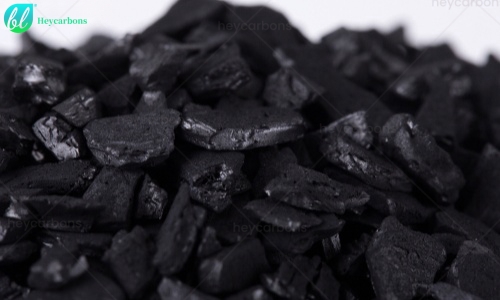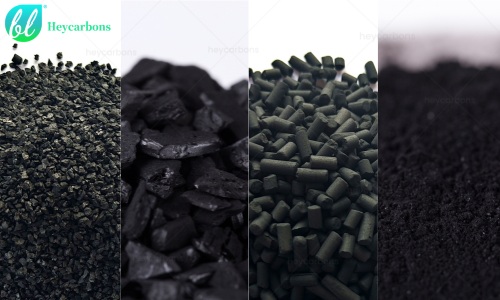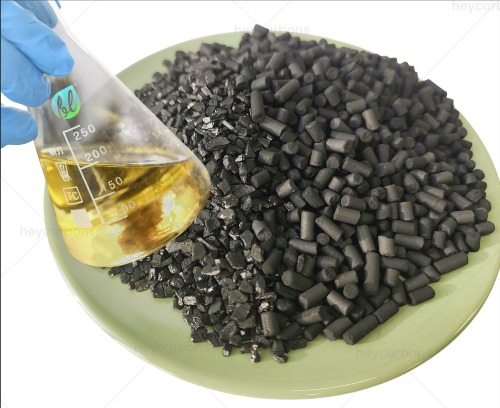Run a Google search and you’ll come across almost 179,000,000 results…
Key points for using or selecting activated carbon in water treatment projects
There are hundreds of procedures you could follow to start your water treatment project.
How do you find a practical way that lead you to the right direction?
To get you an unbiased answer, we asked 10 water treatment professionals a simple question:
If your friend want to start water treatment project, which 3 most important things to note would you recommend him/her?
Here are the top 3 points recommended by the experts… (by vote count)

Yusuf KOZ
Field & Technical Support Engineer on Water Treatment
Environmental Engineer
3 MOST IMPORTANT ISSUES ABOUT INDUSTRIAL TYPE WATER TREATMENT SYSTEMS
1.Design Of Water Treatment System
Design is one of the biggest milestones of an industrial type water treatment system’s journey. It is that much important as like system’s identity and content are defined at this stage. Also, system’s purpose and treatment way are defined at this stage.
Identity, content, purpose and way: These are most important characteristics of any kind of system. In some cases, if design was done wrong and if the system is already built, it is almost impossible to revise and to make that system “working” without extra equipment.
Design mistakes are generally difficult-to-correct mistakes. Those mistakes can be divided two: decisional mistakes and numerical mistakes. Decisional mistakes are sourced from inappropriate choices for treatment method. Suggesting reverse osmosis system without pre-treatment for a water which has high SDI, is an example of decisional mistake.
For this design; reverse osmosis system shall get clogged in a short while and there shall not be any solution without pre-treatment system. Other type of design mistakes is numerical mistakes.
These are sourced from wrong calculations such as choosing a pump which has wrong capacity. If this happens, system may not be fed enough raw water and it shall cause low product water flow rate. There is no another way other than replacing the pump in a such case.
How to consider activated carbon in water treatment system? How to choose activated carbon according to water quality?
In water treatment systems, activated carbon is often used as an effective adsorbent to remove organic matter, odors, colors, and certain chemical pollutants from water. To optimize the treatment process, the selection and use of activated carbon should be determined based on the characteristics of the water quality and the specific treatment goals. The following are key factors to consider:
1. Types of Activated Carbon
Activated carbon typically comes in two main forms: powdered activated carbon (PAC) and granular activated carbon (GAC), each suited for different water treatment needs:
– Powdered Activated Carbon (PAC): PAC has a high surface area and strong adsorption capacity, ideal for short-term treatment or rapid adsorption situations. It is commonly used in drinking water plants or for emergency pollution events.
– Granular Activated Carbon (GAC): GAC is more stable in structure and provides longer-lasting adsorption efficiency, making it suitable for long-term water quality management. It is often used in water treatment plants and industrial wastewater treatment.
2. Adsorption Capacity of Activated Carbon
The adsorption ability of activated carbon is determined by its surface area, pore structure, and surface chemical properties. Different types of activated carbon are more effective at treating different pollutants:
-Micropore Adsorption: Best for adsorbing smaller molecules, such as chlorine and volatile organic compounds (VOCs).
– Mesopore Adsorption: Suitable for removing larger organic molecules, like color, taste, and some heavy metals.
– Macropore Adsorption: Used for the removal of larger particles or complex organic pollutants.
3. Water Quality Characteristics
The selection of activated carbon should match the specific characteristics of the water being treated. For example:
– High Organic Content: Activated carbon with a large surface area and high adsorption capacity is ideal for efficiently removing dissolved organic carbon (DOC).
– Chlorine or Disinfection By-products (DBPs): Microporous carbon is effective at removing residual chlorine or reducing the formation of by-products like trihalomethanes (THMs).
– Chemical Pollutants in Industrial Wastewater: Consider the pollutant type and molecular size. Activated carbon with a macroporous structure is better suited for handling complex organic compounds.
– Color and Odor: These are often caused by organic or inorganic substances. Activated carbon with high adsorption capacity, especially with mesopores or macropores, can effectively remove these contaminants.
4. Regeneration and Replacement of Activated Carbon
– Adsorption Saturation: The adsorption capacity of activated carbon decreases over time, so it must be regularly monitored. Once saturation is reached, the carbon must be regenerated or replaced. Granular activated carbon can be regenerated through high-temperature treatment, while powdered activated carbon is typically single-use.
– Cost and Feasibility of Regeneration: If regeneration is part of the system design, selecting the right type of activated carbon and determining the adsorption capacity are critical. The frequency of regeneration and energy costs should also be factored into the system’s overall costs.
5. System Design and Activated Carbon Dosage
-Contact Time and Dosage: In water treatment systems, contact time (empty bed contact time) and activated carbon dosage directly affect the adsorption efficiency. In water with high organic loads, increasing the dosage of activated carbon or extending the contact time may be necessary.
-Flow Rate Control: For granular activated carbon beds, controlling the flow rate is essential for adsorption performance. Slower flow rates ensure sufficient contact between the water and the carbon, improving adsorption efficiency.
6. Treatment Goals
The selection of activated carbon also depends on the specific treatment goals:
-Removal of Dissolved Organic Matter: Activated carbon with a larger surface area and mesopores is typically required.
– Removal of Pesticides and Industrial Solvents: Activated carbon with specialized surface chemical properties is needed to adsorb complex organic pollutants.
– Improving Drinking Water Quality: In drinking water treatment plants, activated carbon is often used to remove chlorine, odors, and some organic pollutants to ensure water safety.
Conclusion
The selection of activated carbon for water treatment should consider factors like water quality, treatment goals, carbon type and performance, and system design. By conducting a detailed water quality analysis, the proper type and dosage of activated carbon can significantly enhance treatment efficiency and reduce operational costs.
2.Operating Conditions of Water Treatment
Operating conditions are quite important as it can either keep the system working for many years more than expected or cause critical system errors in a few months. It is a crucial factor which can create big differences about system operation. In order to say that a system is being operated under good operating conditions;
- System must be operated by projected raw water characteristics.
- System must give target product water characteristics quantitatively and qualitatively.
- System must need lesser maintenance operations according to similar systems.
- System must have lesser defections according to similar systems.
So how can we provide good operating conditions? Actually, answers of this question are hidden in above points. If the system is operated by designed water characteristics, the system shall give purposed values quantitatively and qualitatively in product water (if system design is made properly).
Other important factor is maintenance. If system maintenance is done properly and regularly, system life time shall become longer, it shall need lesser maintenance operations and it shall have lesser defected parts.
During the operation of the entire water treatment system, the operating precautions of activated carbon?
In the operation of a water treatment system, the use of activated carbon requires attention to several aspects to ensure its adsorption efficiency and the overall performance of the system. The following are key operational considerations when using activated carbon:
1. Pretreatment and Water Quality Monitoring
– Water Pretreatment: Ensure that the water is properly pretreated before flowing into the activated carbon bed or adding powdered activated carbon. This involves removing suspended solids, oils, and large particles to prevent clogging of the carbon’s pores and reduce its adsorption capacity.
– Monitoring Pollutant Concentrations: Regularly monitor the concentration of pollutants in the water, especially the specific substances targeted by activated carbon (e.g., organics, disinfection by-products). Ensure that the water quality entering the activated carbon treatment unit meets design requirements, which can extend the lifespan of the carbon.
2. Control of Activated Carbon Dosage
– Powdered Activated Carbon (PAC): The dosage of PAC should be adjusted based on pollutant concentrations and water quality. Overdosing increases treatment costs and creates additional sludge management challenges, while underdosing reduces adsorption efficiency. Ideally, the optimal dosage is determined through small-scale laboratory tests.
– Granular Activated Carbon (GAC): The bed height and flow rate for GAC should be designed according to treatment needs. Lower flow rates are usually recommended to ensure adequate contact time and enhance adsorption performance.
3. Flow Rate and Contact Time
– Flow Rate Control: For GAC adsorption, controlling the flow rate is crucial. If the water flows too quickly, pollutants may not have sufficient contact with the carbon, reducing the overall adsorption efficiency. Designing the system to maintain a suitable flow rate and allow sufficient contact time (empty bed contact time) is essential.
– Optimizing Contact Time: Longer contact time between the water and activated carbon can improve adsorption efficiency, particularly in complex water quality scenarios with high pollutant concentrations. The design of the activated carbon bed should account for this factor.
4. System Pressure Management
– Pressure Drop Monitoring: Over time, activated carbon beds may become clogged, leading to increased pressure drops in the system. Regularly monitor changes in pressure across the carbon bed. If the pressure drop becomes too high, it may be necessary to replace the carbon or clean the system.
– Even Distribution of Water Flow: Ensure that water flows evenly through the activated carbon bed, avoiding channeling or localized blockages. This ensures uniform adsorption throughout the bed.
5. Regeneration and Replacement of Activated Carbon
– Monitoring Saturation and Regeneration: The adsorption capacity of GAC decreases as pollutants accumulate, so it’s important to monitor its saturation levels regularly. Once saturation is reached, the carbon should be regenerated or replaced. Activated carbon can typically be regenerated through high-temperature treatments, though its adsorption capacity may slightly decrease after regeneration.
– Frequency and Replacement Cycle: For PAC, it is typically single-use and frequently dosed. For GAC, the replacement cycle should be determined based on actual water quality and performance, following a regular maintenance schedule.
6. System Cleaning and Maintenance
– Regular Cleaning: Over time, silt and impurities may accumulate in the activated carbon bed, clogging its pores. Regular backwashing or physical cleaning is needed to maintain the permeability and adsorption efficiency of the bed.
– Equipment Inspection and Maintenance: Regularly inspect and maintain equipment related to activated carbon, such as pumps, valves, and flow meters, to ensure smooth system operation.
7. Pollutant Selectivity and Overload Prevention
– Adsorption Selectivity: Different pollutants exhibit varying adsorption efficiencies on activated carbon. The type of carbon should match the water’s pollutant profile. If there are multiple pollutants, some may compete for adsorption sites, reducing the removal efficiency for certain contaminants. Staged treatment or a combination of different types of activated carbon can optimize the adsorption process.
– Overload Prevention: If pollutant concentrations suddenly spike or exceed the system’s design range, the carbon may become overloaded, reducing adsorption performance. Have a contingency plan, such as temporarily increasing the carbon dosage or adjusting system parameters.
8. Waste Carbon Management and Environmental Compliance
– Disposal of Spent Carbon: After the carbon has reached saturation, especially for PAC, a significant amount of spent carbon is generated. Proper disposal is required, as spent carbon may contain harmful pollutants. Follow environmental regulations for safe disposal or regeneration of spent carbon.
– Environmental Compliance: During regeneration or disposal, it is important to adhere to environmental regulations to prevent secondary pollution. Plan waste carbon treatment in advance to minimize environmental costs and potential legal risks.
Conclusion
The operational management of activated carbon in water treatment involves aspects such as water pretreatment, dosage control, flow rate management, regular maintenance, and regeneration. With careful design and operation, the adsorption efficiency of activated carbon can be maximized, its service life extended, and operational costs and environmental risks reduced.
3.Actual Raw Water Characteristics
What we mean by ‘actual raw water characteristics’ are the water values on site during operation of the system. Actual raw water characteristics are one of the most common reasons for water treatment system problems. Because raw water characteristics are that factor which gets forgotten and/or ignored most due to it is submitted at first step of a water treatment system production.
In a lot of cases, clients just submit and forget their raw water quality parameter values. After this point, almost everything will be defined according to raw water quality parameter values. Water treatment system designer will define principle, equipment, material, instruments, logic, projection, chemicals (if there are) and will make all calculations according to submitted water quality values.
System can handle differences on actual raw water quality values at some level. But if those differences are out of a particular limit, the system may need big revisions for target water parameter values. So, actual raw water characteristics must not be out of that particular limit.
What do we need to do in order to prevent problems caused by this issue? Designer or salesperson must be aware of this and must warn the client about this issue on as much as early stages of the project.
Designer or salesperson must declare to the client that actual raw water characteristics must match with submitted raw water quality characteristics, otherwise client may face serious problems on the system.
Designer or salesperson must be aware of every client is not conscious and may not have enough knowledge about water treatment systems. Even if only client is responsible about what they submitted, it is not a good idea not to inform client about an information like this.
Otherwise, commerce relations between seller and client may get harmed and project completion process may get longer.
 Vishal Bansode
Vishal Bansode
Sales | Business Development| Marketing ( MEE, ZLD, Wastewater treatment, Distillery, Ethanol)
Problems with the sewage treatment plant’s odor
The sulfur-reducing bacterium that thrives in the sewage treatment plants is caused by the presence of hydrogen sulfide, organic acids, and mercaptans. The next product of these bacteria is hydrogen sulfide, or H2S, a colorless, odorous gas that is incredibly caustic.
As a result, it becomes crucial to eliminate hydrogen sulfide gas to avoid equipment problems downstream. Any step could be the source of the odor. The source becomes extremely difficult to identify as a result. You need to contact the plant installers so they may inspect your plant and determine the source of the odor and eliminate it.
nonimpregnated, catalytic, coal-based, activated carbon which has been specially developed for removing Hydrogen Sulfide (H2S) and Sulfur compounds from vapor streams. All are well suited for use in sewage treatment plants and pumping stations where these compounds are typically found.
Heycarbons give you the high loading rates of impregnated carbons without the thermal risks associated with some chemically treated carbons. Additionally, by water washing this product, some if their H2S capacity can be restored.

Marwa Ramadana
Water Treatment & Syrup preparation Manager at Coca-Cola Bottling Company of Egypt
Contaminant Removal By Water Treatment System:
- Microorganisms: Bacteria, viruses, and parasites can contaminate water sources. Solutions include chlorination, UV treatment, and filtration.
Although activated carbon is very effective in removing organic matter, odors and chemical pollutants, its removal effect on microorganisms is limited.
Therefore, when selecting activated carbon, it needs to be considered in combination with other treatment technologies (such as chlorination, ultraviolet treatment and filtration).
Chemical Pollutants: Pesticides, heavy metals. Activated carbon filters, reverse osmosis, and coagulation help remove them.
When it comes to removing chemical pollutants like pesticides and heavy metals from water, activated carbon filters are often used in combination with other treatment methods such as reverse osmosis and coagulation. Each of these methods has specific strengths, and the selection of activated carbon should be carefully tailored to maximize its effectiveness in removing these contaminants. Here’s how to select activated carbon for such situations:
1. Understanding the Role of Activated Carbon for Chemical Pollutants
Activated carbon is highly effective in adsorbing organic chemical pollutants like pesticides and certain industrial solvents, thanks to its large surface area and porous structure. However, its effectiveness against inorganic pollutants like heavy metals is limited unless specially treated. For maximum efficiency, activated carbon is usually paired with other methods like reverse osmosis, which excels in removing heavy metals, or coagulation, which helps bind and remove suspended particles.
2. Key Factors for Selecting Activated Carbon
1. Pore Structure and Surface Area
– Micro- and Mesoporous Activated Carbon: For pesticides and other organic chemicals, selecting activated carbon with a high proportion of micropores and mesopores is critical. These smaller pores increase the contact surface for trapping organic molecules.
– Surface Area: Higher surface area generally means greater adsorption capacity. Choose activated carbon with a large surface area to ensure it can adsorb a significant amount of organic pollutants, especially pesticides.
2. Type of Activated Carbon
– Granular Activated Carbon (GAC): Granular activated carbon is ideal for continuous water treatment applications, as it has a long operational life and provides a high degree of adsorption for pesticides. It’s often used in conjunction with other filtration systems.
– Powdered Activated Carbon (PAC): PAC offers fast adsorption rates due to its high surface area, making it useful for treating water that has been temporarily contaminated with high levels of pesticides or chemical spills. However, it is typically used in one-time applications and needs to be replaced frequently.
3. Surface Chemistry (Modified Activated Carbon)
– Specially Treated Activated Carbon: For heavy metals, standard activated carbon alone is not very effective. However, modified activated carbon impregnated with chemical agents (e.g., sulfur, manganese, or other reactive substances) can bind certain heavy metals, increasing its ability to adsorb metals like mercury, arsenic, and lead.
– Acid-Washed Carbon: Activated carbon that has been acid-washed can be effective in removing certain heavy metals by altering the surface properties and allowing better binding of metal ions.
3. Combination with Reverse Osmosis and Coagulation
– Reverse Osmosis: For heavy metals, reverse osmosis is typically more effective than activated carbon alone. However, when combined with activated carbon, it can provide additional removal of organic chemicals such as pesticides. In this case, activated carbon should be used as a pre-filter to remove organic pollutants, preventing them from clogging the reverse osmosis membrane.
– Coagulation: In systems where coagulation is used, activated carbon helps by adsorbing residual organic compounds or pesticides that remain in the water after coagulation has removed larger suspended particles. The combination ensures a more thorough purification of chemical pollutants.
4. Contaminant-Specific Considerations
1. Pesticides:
– Type of Pesticide: Some pesticides are more effectively removed by activated carbon than others, depending on their chemical structure. For example, hydrophobic pesticides (those that do not dissolve easily in water) tend to be better adsorbed by activated carbon than hydrophilic ones.
– High Adsorption Carbon: Select carbon with a high capacity for adsorbing organic chemicals, as pesticides typically require a high surface area for optimal removal. A detailed analysis of the water’s pesticide content will help in selecting the most effective carbon.
2. Heavy Metals:
– Not Primary for Metal Removal: Activated carbon is not typically the first choice for heavy metal removal. However, modified carbon, particularly those treated with substances like sulfur, can be effective for mercury or arsenic removal. For other heavy metals, such as lead, it’s best to use activated carbon in conjunction with other methods like reverse osmosis or ion exchange.
– Post-treatment Option: In cases where reverse osmosis or coagulation is used as the primary treatment for heavy metals, activated carbon can be employed as a polishing step to remove any residual organic chemicals or to remove dissolved metals after they have been transformed into more adsorbable forms during the treatment process.
5. Choosing Based on System Design
– Flow Rate and Contact Time: For efficient removal of pesticides and chemical pollutants, the flow rate through the activated carbon filter should be low enough to provide sufficient contact time for adsorption. Systems should be designed to optimize empty bed contact time (EBCT), as this will affect the overall efficiency of chemical pollutant removal.
– Filter Maintenance: Activated carbon’s capacity to adsorb chemical pollutants decreases as it becomes saturated. Regular maintenance, including monitoring the performance of the activated carbon and replacing it as needed, is crucial to ensure ongoing removal of pollutants like pesticides and heavy metals.
6. Environmental Considerations
– Disposal of Spent Carbon: Activated carbon used to adsorb pesticides and heavy metals must be disposed of properly, as it can accumulate toxic substances. Consider the cost and environmental impact of regenerating or replacing the carbon, especially when dealing with chemical pollutants.
Conclusion
When selecting activated carbon for the removal of chemical pollutants like pesticides and heavy metals, it is essential to consider the type of contaminants, the system design, and the need for combining activated carbon with other treatment methods like reverse osmosis or coagulation. Activated carbon is most effective at removing organic chemicals like pesticides, while specially treated or modified activated carbon can enhance its capacity to deal with certain heavy metals. By carefully choosing the right type of activated carbon and integrating it with complementary processes, you can maximize water treatment efficiency and achieve cleaner, safer water.
Waste Disposal: Proper disposal of sludge and waste generated during treatment by Improved waste management practices
In water treatment processes, proper waste disposal is a critical step to ensure the environmental sustainability and efficiency of the system. Large amounts of sludge and waste are generated during water treatment, and improper disposal can lead to environmental contamination. Therefore, **improved waste management practices** are essential to ensure that sludge and other waste materials are handled appropriately.
1. Sources of Sludge
In water treatment, sludge mainly originates from the following stages:
– Pretreatment Stage: Primary sludge is generated by removing suspended solids and particles from wastewater through sedimentation or coagulation. This sludge often contains a high concentration of organic matter and particles.
– Biological Treatment Stage: In processes like activated sludge systems, microorganisms degrade organic matter in wastewater, producing excess sludge. This sludge contains a large amount of biomass, organic matter, and potentially harmful substances.
– Chemical Treatment Stage: When chemicals like coagulants and flocculants are used, they generate precipitates and chemical residues that also contribute to sludge formation.
– Filtration and Activated Carbon Adsorption: These steps may generate waste filter media or spent carbon, which require proper disposal.
2. Challenges in Sludge and Waste Management
Waste (such as sludge, spent carbon, and chemical precipitates) generated during water treatment needs proper handling, and the challenges include:
– Large Volumes: Sludge is often produced in large quantities and has a high water content, making dewatering and volume reduction a significant challenge in sludge management.
– Hazardous Substances: Sludge may contain heavy metals, pathogenic microorganisms, and chemical residues, making improper disposal a potential source of environmental contamination.
– Cost of Treatment: Sludge treatment is a major component of water treatment costs, so selecting economical and environmentally friendly disposal methods is crucial.
3. Improved Sludge Treatment and Disposal Measures
To address the complexities and environmental requirements of sludge management, the following improved sludge management practices can be implemented:
1. Sludge Thickening and Dewatering
– Sludge Thickening: Before sludge is treated, it needs to be thickened to reduce its volume. Common methods include gravity thickening and flotation thickening, which remove excess water from the sludge to make it easier to handle.
– Dewatering: After thickening, sludge can be further dewatered using mechanical equipment like filter presses, centrifuges, or belt presses, which significantly reduce the water content and volume of the sludge, lowering transportation and disposal costs.
2. Sludge Stabilization
– Chemical Stabilization: Chemical agents (such as lime) can be added to stabilize the sludge, preventing the further breakdown of organic matter and reducing odor and pathogen activity.
– Biological Stabilization (Anaerobic Digestion): Anaerobic digestion can be used to stabilize sludge. This process involves microorganisms breaking down organic matter, producing biogas (which can be used for energy recovery), while also reducing the organic content and pathogen levels in the sludge, minimizing secondary pollution.
3. Resource Recovery from Sludge
– Land Application: Stabilized sludge can be used in agriculture as fertilizer or soil conditioner, as it is rich in organic matter and nutrients (like nitrogen, phosphorus, and potassium). However, heavy metals and harmful substances must meet land application standards.
– Energy Recovery: Biogas produced through anaerobic digestion can be used for electricity generation or heating, helping to realize the energy potential of sludge. Additionally, sludge incineration can recover heat energy, which can be used for power or heating.
– Brick or Cement Production: The ash produced after sludge incineration can be used in the production of bricks or cement, turning waste into valuable construction materials.
4. Incineration and Landfilling
– Sludge Incineration: For sludge containing high levels of toxic and hazardous substances that cannot be recycled, incineration can significantly reduce the volume and destroy harmful components. The ash produced after incineration is more stable and can be further treated or used in construction materials.
– Sanitary Landfill: For sludge that cannot be further utilized, sanitary landfills are the final disposal option. This must be done at a landfill site with proper lining and leachate collection systems to prevent groundwater and soil contamination.
4. Chemical Waste Management
Besides sludge, chemical waste, such as residual coagulants, flocculants, and spent activated carbon, is also generated during water treatment. Proper management of this waste requires attention to:
– Segregation and Disposal: Different types of chemical waste should be segregated to avoid cross-contamination. Spent activated carbon, for example, can be regenerated through high-temperature treatment and reused.
– Hazardous Waste Handling: Some chemical waste may contain toxic substances (e.g., heavy metals, residual chemicals) and should be handled and disposed of according to hazardous waste regulations to ensure safety and compliance with environmental laws.
5. Benefits of Improved Waste Management Practices
– Reducing Environmental Pollution: Improved waste management practices prevent the discharge of untreated waste into the environment, particularly the release of hazardous substances.
– Resource Conservation: Through resource recovery and energy reuse, waste can be recycled, reducing the overall cost of water treatment and decreasing reliance on natural resources.
– Cost Efficiency and Compliance: Efficient waste management practices reduce the cost of sludge and waste treatment and ensure compliance with local environmental regulations, lowering legal risks for the organization.
Conclusion
Proper disposal of sludge and waste is key to ensuring the effective operation of water treatment systems and environmental protection. By adopting improved waste management practices such as thickening, dewatering, stabilization, and resource recovery, the environmental impact of waste can be minimized while maximizing economic benefits through energy recovery and recycling.
Combining these measures with appropriate segregation and disposal methods will significantly enhance the sustainability and efficiency of water treatment systems.
To be continued…
learn more:






